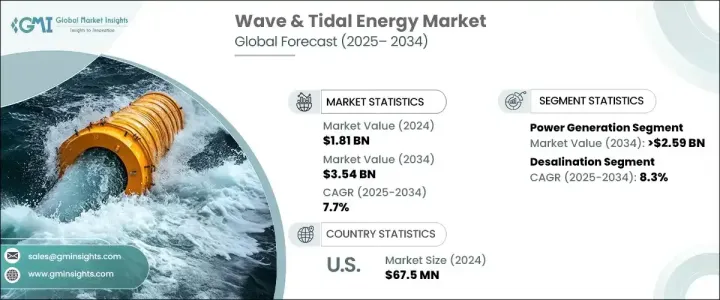 |
市場調查報告書
商品編碼
1684638
波浪能和潮汐能市場機會、成長動力、產業趨勢分析和 2025 - 2034 年預測Wave and Tidal Energy Market Opportunity, Growth Drivers, Industry Trend Analysis, and Forecast 2025 - 2034 |
||||||
2024 年全球波浪能和潮汐能市場估值達到 18.1 億美元,預計 2025 年至 2034 年期間將以 7.7% 的強勁複合年成長率成長。波浪能利用主要由風產生的海面波浪的動能和位能,而潮汐能則利用地球、月球和太陽之間的引力交互作用所造成的海平面上升和下降。二者共同代表了再生能源領域一個充滿希望的前沿。

隨著全球對清潔能源的關注度不斷提高,波浪能和潮汐能已成為永續發電的主要貢獻者。它們對環境的影響極小,再加上豐富的海洋資源,使它們成為緩解氣候變遷的關鍵解決方案。世界各國政府正透過財政激勵、試點計畫和補貼等方式積極支持此產業,為技術進步和商業化鋪路。能源轉換系統、材料和部署技術的創新進一步提高了這些技術的效率和成本效益,吸引了投資者和利害關係人的極大興趣。
| 市場範圍 | |
|---|---|
| 起始年份 | 2024 |
| 預測年份 | 2025-2034 |
| 起始值 | 18.1億美元 |
| 預測值 | 35.4 億美元 |
| 複合年成長率 | 7.7% |
預計發電產業將成為該市場的主要驅動力,預計到 2034 年將達到 25 億美元。技術進步正在提高能源轉換效率,使波浪能和潮汐能系統比風能和太陽能等其他再生能源更具競爭力。這些進步不僅促進了技術的採用,而且還促進了再生能源結構的多樣化。
在擴大再生能源的強烈推動下,美國波浪能和潮汐能市場預計到 2034 年將創造 1.4 億美元。政府政策和激勵措施(例如美國能源部(DOE)的資助)在這一成長中發揮關鍵作用。這些舉措包括對研究和開發進行大量投資,特別是旨在證明波浪和潮汐技術的可行性和可擴展性的試點計畫。材料和能源轉換系統的不斷改進,進一步推動了高效且經濟的解決方案的部署,使美國成為再生能源轉型的領導者。
目錄
第 1 章:方法論與範圍
- 市場定義
- 基礎估算與計算
- 預測計算
- 初步研究與驗證
- 主要來源
- 資料探勘來源
- 市場定義
第 2 章:執行摘要
第 3 章:產業洞察
- 產業生態系統
- 監管格局
- 產業衝擊力
- 成長動力
- 產業陷阱與挑戰
- 成長潛力分析
- 波特的分析
- PESTEL 分析
第4章:競爭格局
- 介紹
- 戰略儀表板
- 創新與永續發展格局
第 5 章:市場規模與預測:按應用,2021 – 2034 年
- 主要趨勢
- 發電
- 海水淡化
- 其他
第6章:市場規模及預測:按地區,2021 – 2034 年
- 主要趨勢
- 北美洲
- 美國
- 加拿大
- 歐洲
- 法國
- 西班牙
- 英國
- 挪威
- 亞太地區
- 中國
- 印度
- 韓國
- 世界其他地區
第7章:公司簡介
- AquaWave & Tidal Power
- BioPower Systems
- CorPower Ocean
- Carnegie Clean Energy
- Eco Wave Power Global
- Inyanga Marine Energy Group
- Minesto
- Nova Innovations
- Orbital Wave & Tidal Power
- Ocean Renewable Power Company
- SINN Power
- SSE Renewables
The Global Wave And Tidal Energy Market achieved a valuation of USD 1.81 billion in 2024 and is projected to grow at a robust CAGR of 7.7% from 2025 to 2034. These renewable energy sources leverage the immense power of water movement, offering a sustainable alternative to traditional energy forms. Wave energy taps into the kinetic and potential energy of ocean surface waves, generated primarily by wind, while tidal energy harnesses the rise and fall of sea levels caused by the gravitational interactions between the Earth, moon, and sun. Together, they represent a promising frontier in the renewable energy landscape.

As the global focus on clean energy intensifies, wave and tidal energy have emerged as key contributors to sustainable power generation. Their minimal environmental impact, coupled with the abundant availability of ocean resources, positions them as critical solutions for mitigating climate change. Governments worldwide are actively supporting this industry through financial incentives, pilot programs, and subsidies, paving the way for technological advancements and commercialization. Innovations in energy conversion systems, materials, and deployment techniques are further improving the efficiency and cost-effectiveness of these technologies, attracting significant interest from investors and stakeholders.
| Market Scope | |
|---|---|
| Start Year | 2024 |
| Forecast Year | 2025-2034 |
| Start Value | $1.81 Billion |
| Forecast Value | $3.54 Billion |
| CAGR | 7.7% |
The power generation segment is expected to be a primary driver for this market, with estimates suggesting it will reach USD 2.5 billion by 2034. The growing urgency to reduce greenhouse gas emissions has made wave and tidal energy a preferred choice for sustainable power solutions. Advances in technology are enhancing energy conversion efficiency, making wave and tidal systems more competitive against other renewable energy sources like wind and solar. These advancements are not only fostering technology adoption but also contributing to the diversification of the renewable energy mix.
The U.S. wave and tidal energy market is projected to generate USD 140 million by 2034, driven by a strong commitment to expanding renewable energy sources. Government policies and incentives, such as funding from the U.S. Department of Energy (DOE), play a pivotal role in this growth. These initiatives include substantial investments in research and development, particularly in pilot projects designed to demonstrate the feasibility and scalability of wave and tidal technologies. Continuous improvements in materials and energy conversion systems are further enabling the deployment of efficient and cost-effective solutions, positioning the U.S. as a leader in the renewable energy transition.
Table of Contents
Chapter 1 Methodology & Scope
- 1.1 Market definitions
- 1.2 Base estimates & calculations
- 1.3 Forecast calculation
- 1.4 Primary research & validation
- 1.4.1 Primary sources
- 1.4.2 Data mining sources
- 1.5 Market definitions
Chapter 2 Executive Summary
- 2.1 Industry synopsis, 2021 – 2034
Chapter 3 Industry Insights
- 3.1 Industry ecosystem
- 3.2 Regulatory landscape
- 3.3 Industry impact forces
- 3.3.1 Growth drivers
- 3.3.2 Industry pitfalls & challenges
- 3.4 Growth potential analysis
- 3.5 Porter's analysis
- 3.5.1 Bargaining power of suppliers
- 3.5.2 Bargaining power of buyers
- 3.5.3 Threat of new entrants
- 3.5.4 Threat of substitutes
- 3.6 PESTEL analysis
Chapter 4 Competitive landscape, 2024
- 4.1 Introduction
- 4.2 Strategic dashboard
- 4.3 Innovation & sustainability landscape
Chapter 5 Market Size and Forecast, By Application, 2021 – 2034 (USD Million & MW)
- 5.1 Key trends
- 5.2 Power generation
- 5.3 Desalination
- 5.4 Others
Chapter 6 Market Size and Forecast, By Region, 2021 – 2034 (USD Million & MW)
- 6.1 Key trends
- 6.2 North America
- 6.2.1 U.S.
- 6.2.2 Canada
- 6.3 Europe
- 6.3.1 France
- 6.3.2 Spain
- 6.3.3 UK
- 6.3.4 Norway
- 6.4 Asia Pacific
- 6.4.1 China
- 6.4.2 India
- 6.4.3 South Korea
- 6.5 Rest of World
Chapter 7 Company Profiles
- 7.1 AquaWave & Tidal Power
- 7.2 BioPower Systems
- 7.3 CorPower Ocean
- 7.4 Carnegie Clean Energy
- 7.5 Eco Wave Power Global
- 7.6 Inyanga Marine Energy Group
- 7.7 Minesto
- 7.8 Nova Innovations
- 7.9 Orbital Wave & Tidal Power
- 7.10 Ocean Renewable Power Company
- 7.11 SINN Power
- 7.12 SSE Renewables








